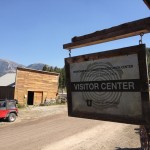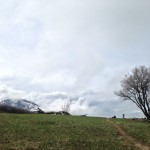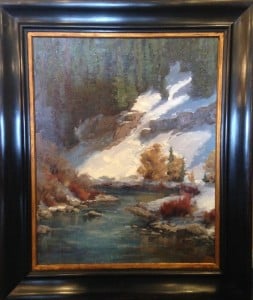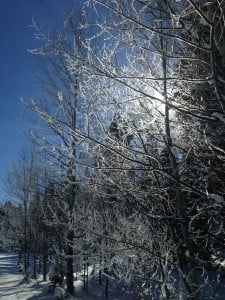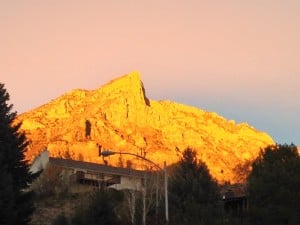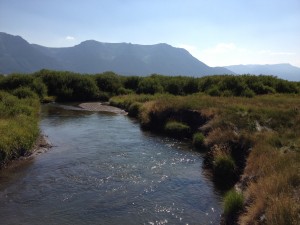 We began the second day discussing the art of nature writing. Tom had asked the day before, “Who do you think you are?” I asked: “Where do you think you are?” I suggested that nature writing is a kind of reconnaissance, an exercise in inhabitation, or as Annie Dillard puts it, an exploration of the neighborhood. Of course other art forms work to this end as well, but nature writing is a terrific way to literally ground your thinking and build some specific content into your growing affections for a place. It makes love of place less of a theoretical or vague idea and more of a committed relationship. And this is no mere exploration of a few streets or hiking trails. It has cosmological significance. So I brought in my favorite quote from the novelist, Marilynne Robinson, from an interview I did with her 8 years ago. She said:
We began the second day discussing the art of nature writing. Tom had asked the day before, “Who do you think you are?” I asked: “Where do you think you are?” I suggested that nature writing is a kind of reconnaissance, an exercise in inhabitation, or as Annie Dillard puts it, an exploration of the neighborhood. Of course other art forms work to this end as well, but nature writing is a terrific way to literally ground your thinking and build some specific content into your growing affections for a place. It makes love of place less of a theoretical or vague idea and more of a committed relationship. And this is no mere exploration of a few streets or hiking trails. It has cosmological significance. So I brought in my favorite quote from the novelist, Marilynne Robinson, from an interview I did with her 8 years ago. She said:
“There’s probably nothing stranger than the fact that we exist on a planet. Very odd. Who does not feel the oddness of this? I mean, stop and think about where we actually are in the larger sense. It seems to me as if every local landscape is a version of the cosmic mystery, that it is very strange that we’re here, and that it is very strange that we are what we are. In a certain sense the mystery of the physical reality of the human being is expressed in any individual case by the mystery of a present landscape. The landscape is ours in the sense that it is the landscape that we query. So, we’re created in the fact of ourselves answering to a particular sense of amazement.”
Robinson’s point seems to be that fundamental to our experience of being human is the experience of amazement and awe. The weight of awe is sometimes too much for us, so we grow lazy and prefer instead to keep our relationship to our surroundings on a superficial level to the point of boredom. But all great literature and art are born of a sense of surprised and unanticipated wonder. And what is especially remarkable is that great art is rarely about exotic or foreign landscapes but about the most intimately known landscapes of home. It is as if art defamiliarizes the familiar and allows us to see what has been seen many times before, as if for the first time. In this sense, artistic ways of seeing nature remake the world and help to remake us, to bring us into the world again with fresh eyes. Seeing nature should never be a cliché or a monotonous routine.
We had read Wallace Stegner’s essay, “A Sense of Place,” and discussed three aspects of how to establish a deeper sense of belonging in the landscapes we occupy. We began first with the need for a sense of history. It is vital that we learn our local history, our local lore, that we know key landmarks, legends, and stories so that we can see all human citizens of a place through as much human time as a place has. This changes the way we see what is before us. A parking lot or a nondescript street corner could very well be the site of important historical events and beginnings to a community. And we need to find a way to tie our own story into the broader human history of our home. We read the poem, “History” by Wendell Berry as an example, where he describes eating fruit of his garden, knowing that in the soil of the place is contained the entirety of its human history.
Secondly, we need a sense of ecology. We need to know as much as we can about the ecological conditions, the interdependencies, and the flora and fauna of the region. We need to know our watersheds, our climate’s tendencies, and the place’s vulnerabilities. The ecological story of a place situates its history in even deeper time and challenges our imagination to be inclusive of an even broader more-than-human community. We read a Mary Oliver poem, “The Chance to Love Everything,” that describes her sense of ecological wonder in the community of animals in which she finds herself.
Finally, I suggested that we need a sense of spirituality. We need to find a purpose, a calling, a sense of responsibility toward where we live. We need to identify what is sacred and guard and protect it. We need to recognize the ways in which our home witnesses the divine and then seek ways to bear testimony to that divinity. As an example, we read the poem, “The Grandeur of God” by Gerard Manley Hopkins.
I challenged the participants to spend that afternoon at Elk Lake and Hidden Lake on the west side of the valley contemplating and then writing what they saw. I suggested that mere imitation of the landscape through description would be a good place to start and that with time they can begin to find a way to narrate how their own story merges with the story of land. I didn’t expect too much, since this isn’t a writing workshop, but in my next entry I will describe something of the marvelous writing that emerged. The lakes were wonderful, enjoyed on kayaks and on the shores, as the afternoon breezes picked up on an otherwise warm day.
Afterwards, Sam and I joined Frank Carter for a few hours of fishing on Red Rock Creek nearby. It was a long and muddy slog through moose country to get far enough down the creek where the best fish were. Frank was a great guide for Sam, helping him to spot fish and to improve his cast. We caught several fish each, mostly large Artic Graylings, from about 14 to 19 inches in length, and one large cutthroat trout. The Graylings are surprisingly beautiful. They don’t have the variety of color on their sides like the trout, but their silver skin is complemented by splashes of rust colors on the fins and iridescent blue spots as well on their dorsal fins which fan out like a sun fish. Sam managed a few catches all by himself, and he walked back to our car when it was all over with an immense sense of satisfaction. Frank earned my profound gratitude for helping advance my son’s confidence in fishing.
That evening we listened to John Taft talk to us about how Providence guided him to find this property and to purchase it, which launched him on his journey to preserve this valley. I won’t recount the whole story, but it boiled down to a very long and fruitless search for a special place he hoped would be somewhere in the West. And when he finally pled to God in a vocal prayer, asking for help, he felt he heard a voice that said, “So you still believe in me after all these years?” And almost immediately he was led to the right person who could sell him the property he wanted, against odds and after a series of rapid and serendipitous circumstances. He heard the voice again: “Was that fast enough for you?” He is an endearing and funny man, someone who has a hint of Jimmy Stewart about him, a dignified elderly man, with a tender and loving granddaughter at his side who aspires to help carry on his environmental cause into the future. He was so glad to have us here, and we were fortunate to experience his magnanimity.

